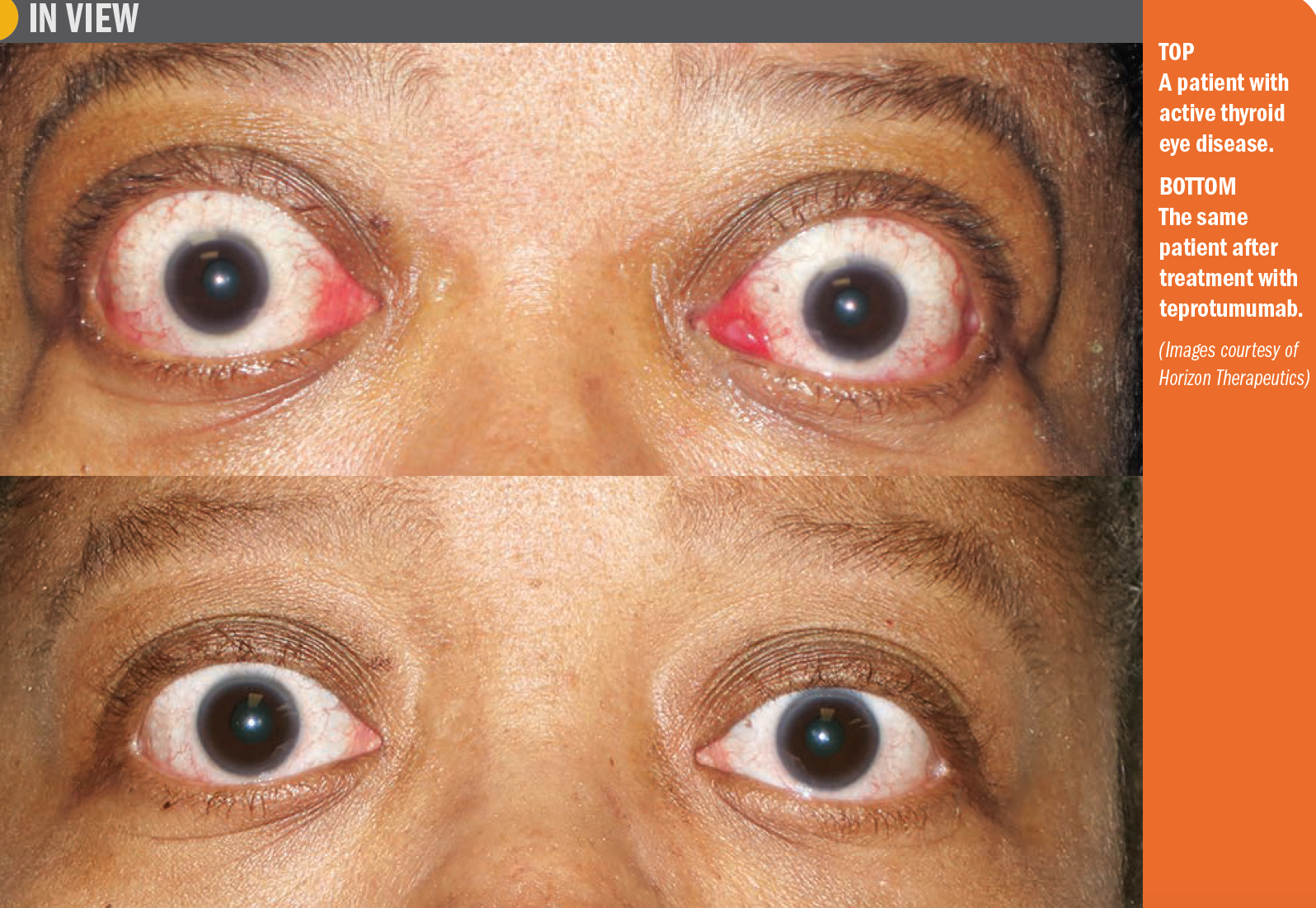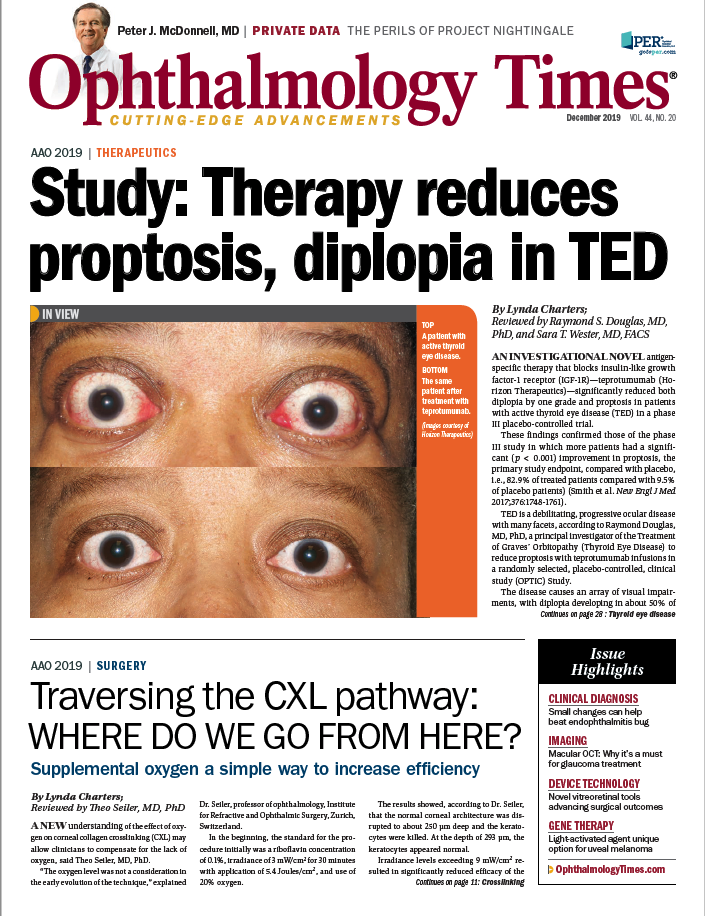Publication
Article
Digital Edition
Study: Therapy reduces proptosis, diplopia in TED
Author(s):

Reviewed by Raymond S. Douglas, MD, PhD, and Sara T. Wester, MD, FACS
An investigational novel antigen-specific therapy that blocks insulin-like growth factor-1 receptor (IGF-1R)-teprotumumab (Horizon Therapeutics)-significantly reduced both diplopia by one grade and proptosis in patients with active thyroid eye disease (TED) in a phase III placebo-controlled trial.
These findings confirmed those of the phase III study in which more patients had a significant (p < 0.001) improvement in proptosis, the primary study endpoint, compared with placebo, i.e., 82.9% of treated patients compared with 9.5% of placebo patients) (Smith et al. New Engl J Med 2017;376:1748-1761).
Related: Considering use of teprotumumab in thyroid eye disease patients
TED is a debilitating, progressive ocular disease with many facets, according to Raymond Douglas, MD, PhD, a principal investigator of the Treatment of Graves’ Orbitopathy (Thyroid Eye Disease) to reduce proptosis with teprotumumab infusions in a randomly selected, placebo-controlled, clinical study (OPTIC) Study.
The disease causes an array of visual impairments, with diplopia developing in about 50% of patients, a complication that severely affects patient quality of life and the clinical activity score (CAS), which assesses the activity of TED.
Strabismus and blindness are other potential complications, said Dr. Douglas, professor of surgery, Division of Ophthalmology, and director, Orbital and Thyroid Eye Disease Center, Cedars Sinai Medical Center, Los Angeles. Given the severity of the disease, the need for a treatment is clear-specifically, a treatment that provides molecular targeting of the antigen, he explained.
Sara Tullis Wester, MD, FACS, noted that TED has become an area of interest for her because of the impact the disease has on patients’ lives physically, psychologically, and emotionally.
Related: Role of suture in securing extraocular muscles in strabismus surgery
“It is exciting for me to see that we might have a treatment that could be disease-altering, considering the impact that the disease has on them,” said Dr. Wester, subinvestigator in the OPTIC study, and associate professor of clinical ophthalmology, Bascom Palmer Eye Institute, University of Miami Miller School of Medicine, Miami.
TED has an initial active phase followed by a stable phase.
“The ideal treatment would alter that course by altering the disease in the active phase leading to less long-term sequelae,” Dr. Wester said.
Medical treatments used for TED, none of which is FDA approved, include steroids, radiation, tocilizumab, rituximab, and others, and are less than ideal, Dr. Wester noted.
Related: New for 2020 and beyond: Dry eye disease agents in pipeline
Phase III study, results
The study was a multicenter, 24-week, randomized, double-masked, placebo-controlled treatment trial that included patients aged 18 to 80 years who had not undergone a previous treatment for TED and had active disease for less than nine months.
Patients randomly assigned to both active treatment (n = 41) and placebo (n = 42) underwent standardized infusions every three weeks, for a total of eight infusions. The doses begin at 10 mg/kg and go to 20/mg/kg; the first two doses are administered over 90 minutes and subsequent doses are given over 60 minutes.
The primary endpoint was a 2-mm or greater improvement in proptosis at week 24. A total of 39 and 40 patients, respectively, completed the treatment period.
Related: Ocular surface inflammation: Vicious cycle of ocular surface disruption
The patients treated with teprotumumab had marked and early improvements in proptosis compared with those randomized to placebo, Dr. Wester noted, with 82.9% meeting the study criterion of greater than 2 mm of improvement, which translated to almost a 75% difference from the placebo group (p < 0.001).
The OPTIC study also showed improvement in the secondary endpoints. “We found that at week 24, 68% of patients treated with teprotumumab had a significant (p = 0.001) improvement from baseline of at least one grade of diplopia, compared to 29% of patients randomized to placebo. This endpoint measured the percentage of patients who reported at least some diplopia at baseline in the study eye and who had a reduction of grade 1 or higher with no corresponding deterioration (≥1 grade worsening) in the fellow eye at week 24,” Dr. Douglas said. The active-treatment group differed from the placebo group by more than 39% in improvement in diplopia.
The results also showed that the active-treatment patients had a significant (p = 0.001) improvement in quality of life of 13.79 measured on the Graves’ Ophthalmopathy Quality of Life scale compared with a change of 4.43 for patients randomized to placebo. He explained that a change of 6 points of the scale is considered clinically significant.
Related: Physicians treat a patient with right eye-proptosis
At week 24, the investigators found that 59% of patients randomized to teprotumumab achieved a CAS value of 0 or 1 compared with 21% of those randomized to placebo, a difference that also reached significance (p < 0.001). The CAS scale ranges from 0 to 7, with 0 indicating no swelling or activity.
The phase II study found that adverse events were mild to moderate in intensity and no non-serious events led to discontinuation. In the phase III trial, the safety profile was similar to the phase II study with no new safety observations. The drop-out rate was below 5%. No deaths were related to treatment.
The most frequent adverse reactions related to teprotumumab were muscle spasm, hyperglycemia, hearing-impairment, and infusion-related reaction, all of which resolved by the end of treatment.
Related: When glaucoma and orbit collide
These results seem to tick most of the boxes regarding Drs. Douglas and Wester’s definition of an ideal treatment for TED: decreased inflammatory signs, reduced proptosis and underlying pathology, reduced diplopia, improved quality of life, and minimal side effects.
The long-term duration of the responses to teprotumumab remains to be determined. An extension study is currently underway, according to Dr. Wester.
“That study will provide more data on the stability of the response,” she said. “Because I treat many TED patients, the idea that we actually have the potential for a therapy that could alter the course of this disease and improve the patients’ quality of life in a much more meaningful way than the previously non-FDA-approved treatments is very exciting to me.”
Related: 5 ways to integrate ocular surface into your patient's regimen
Dr. Douglas also found the phase III results encouraging.
“This pivotal phase III, placebo-controlled study of teprotumumab demonstrated a significant reduction in proptosis, confirming the phase II study results seen with this targeted IGF-1R inhibitor for treating TED,” he said. “These results confirm that teprotumumab is effective in reducing proptosis, supporting a positive benefit/risk profile in the treatment of TED with apparent disease-modifying activity.”
Teprotumumab has received Priority Review, Orphan Drug, Fast Track, and Breakthrough Therapy designations from the FDA.
Read more by Lynda Charters
Raymond S. Douglas, MD, PhD
E: raymonddouglasmd@gmail.com
Dr. Douglas is a consultant to Horizon Therapeutics.Sara T. Wester, MD, FACS
E: swester2@med.miami.edu
Dr. Wester is a consultant/advisor to Horizon Therapeutics.
Newsletter
Don’t miss out—get Ophthalmology Times updates on the latest clinical advancements and expert interviews, straight to your inbox.





